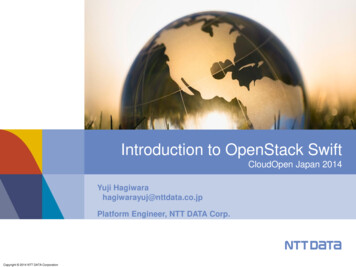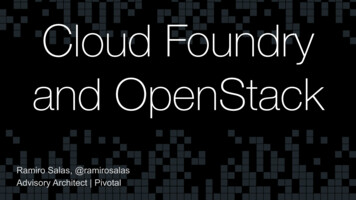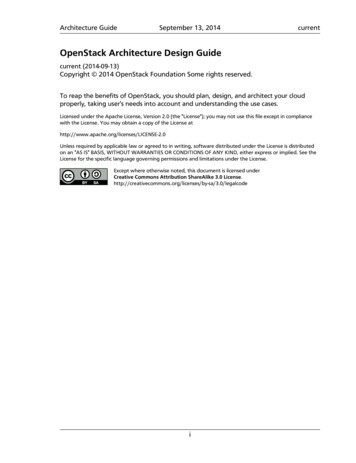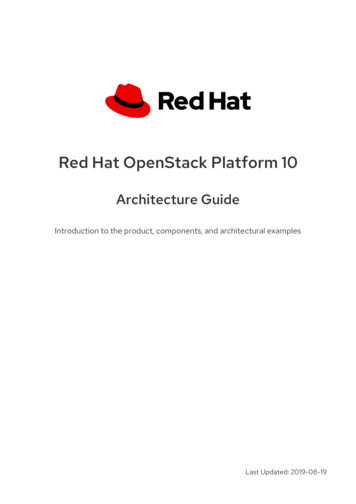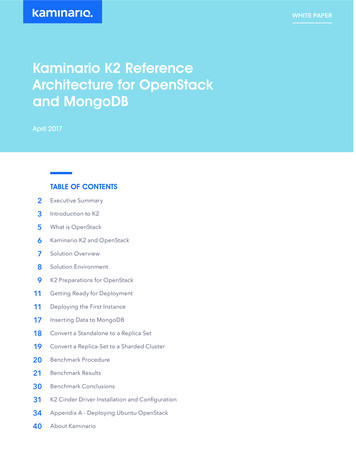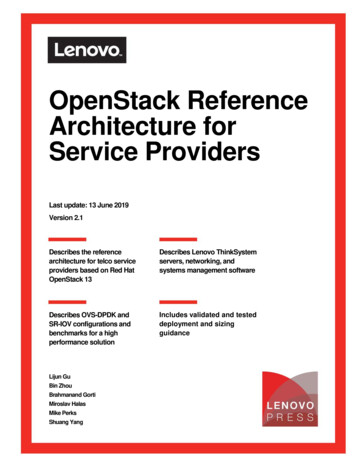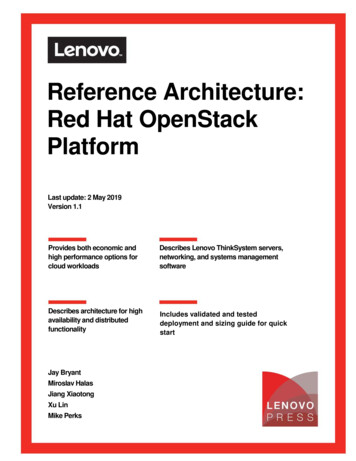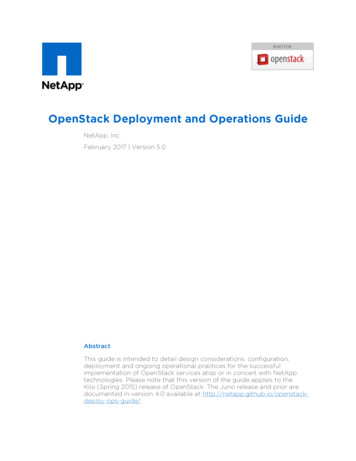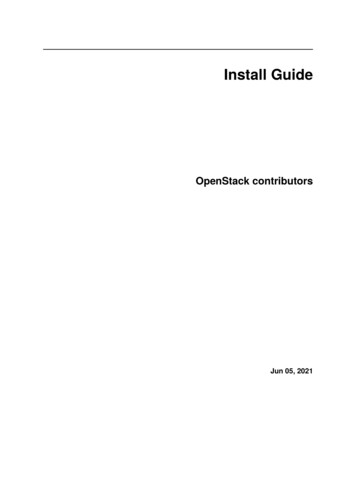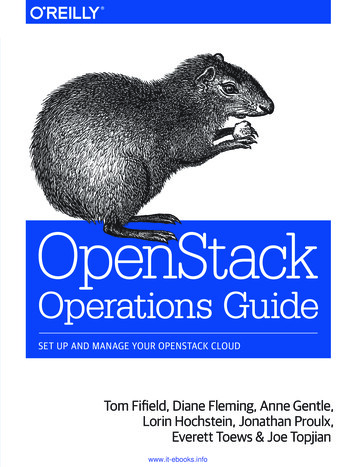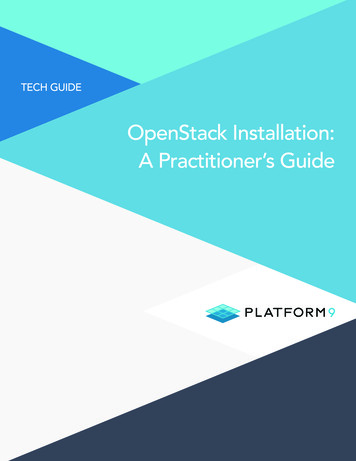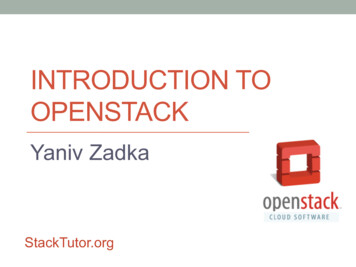
Transcription
INTRODUCTION TOOPENSTACKYaniv ZadkaStackTutor.org
Agenda What is OpenStack? Getting your hands dirty with OpenStack A little bit about OpenStack networking Demo
What is OpenStack?
What is OpenStack?OpenStack is a free and open-sourceplatform for building and managing privateand public clouds. It is a stack ofindependent projects that are designed towork with each other and control large poolsof compute, storage, and networkingresources throughout a datacenter.Some may call it the “Linux of the cloud”.
What is OpenStack? OpenStack is backed by some of the biggestcompanies like Red Hat, Cisco and HP and havea strong growing community worldwide. Most code is written in Python 2.x (and not 3.x). All of the code for OpenStack is freely availableunder the Apache 2.0 license. OpenStack is managed by the OpenStackFoundation, a non-profit which oversees bothdevelopment and community-building around theproject.
What is OpenStack? - HistoryStarted as a co-project ofNASA and a cloud hostingcompany called RackSpacein July 2010.The early code came fromthe NASA Nebula andRackspace Cloud Files platforms helpingorganizations to offer cloud-computing servicesrunning on standard hardware.
What is OpenStack? - History The first official release, code-named Austin, wasout in late 2010, with plans to release regularupdates of the software every few months. Austinincluded only two development projects - compute(Nova) and object storage (Swift). In July 2011, Ubuntu Linux developers adoptedOpenStack. Red Hat announced a preview of theirdistribution in 2012. OpenStack fall 2012 release, code-named Folsom,included image, identity, network, block storage andGUI on top of the compute and object storageservices introduced in the Austin initial release.
What is OpenStack? OpenStack release cycle is every six months with aDesign Summit taking place immediately after. Currently,OpenStack Kilo has just been released and the Summitfor the next OpenStack release Liberty will be held inVancouver on May 18-22, 2015. OpenStack is aimed for enterprises, service providers,government and academic institutions with physicalhardware that would like to build a public or private cloud. OpenStack is being used by organizations like eBay/PayPal, Walmart, Cisco WebEx, BestBuy, RackSpaceCloud and HP and Public Cloud.
What is OpenStack? – Useful Lingo Tenants or Projects – OpenStack users belonging to aspecific group. Multi-tenancy is used to isolate access tovarious cloud resources. For example, Marketing andEngineering can be two tenants with multiple usersaccessing compute, networking or storage resources inan enterprise OpenStack Cloud. Company A andCompany B can be two tenants in Public Cloud provider. Instance – a running VM or container (e.g. Docker). Components or Services – OpenStack has a modulararchitecture with various code names for its components.Each of the OpenStack cloud services such as compute,network or even GUI are developed under a separateOpenStack development project.
What is OpenStack? – Horizon Horizon is the dashboard behind OpenStack. It isthe GUI to OpenStack and can be customized. Admins and users can access, provision andautomate cloud based-resources. Developers can access all of the components ofOpenStack individually using native API or AWSEC2 compatible API.
What is OpenStack? – Keystone Keystone provides identity services forOpenStack. Allow admins configuration of centralized policiesacross users and systems. Creation of users and tenants and definepermissions for cloud resources. Integration with an existing directory, like LDAP, toprovide a single source of authentication acrossthe enterprise. Allow users to log into GUI and list services towhich they have access.
What is OpenStack? – Nova Nova is the primary computing engine behindOpenStack. It is a "fabric controller," which isused for deploying and managing large numbersof virtual machines and other instances to handlecomputing tasks. Users are able launch, resize suspend stop andreboot through integration with a set of supportedhypervisors KVM/QEMU, ESXi, Xen and evenDocker.
What is OpenStack? – Neutron Neutron (formerly called Quantum) provides thenetworking capability for OpenStack. It is analternative to the soon-to-be-deprecated novanetworking. It helps to ensure that each of the components ofan OpenStack deployment can communicate withone another quickly and efficiently. Users can define networks, subnets and routersto configure their internal topology, and thenallocate IP addresses and VLANs to thesenetworks.
What is OpenStack? – Cinder Cinder is a block storage component that manage thepersistent block-level storage that compute instancesuse. The block storage system manages the creation,attaching and detaching of the block devices to servers.Block storage volumes are fully integrated intoOpenStack Compute and the Dashboard allowing forcloud users to manage their own storage needs. This more traditional way of accessing files might beimportant in scenarios in which data access speed is themost important consideration like in databases andexpandable file systems.
What is OpenStack? – Swift Swift is the a storage system for objects and files. Objects and files are written to multiple disk drivesspread throughout servers in the data center, withthe OpenStack software responsible for ensuringdata replication and integrity across the cluster. Object Storage is not a traditional file system, butrather a distributed storage system for static datasuch as virtual machine images, photo storage,email storage, backups and archives. Having nocentral "brain" or master point of control providesgreater scalability, redundancy and durability.
What is OpenStack? – Glance Glance provides a catalog and repository imageservices to OpenStack. Allows these images to be used as templateswhen deploying new virtual machine instances. Users can provide both private and public imagesto the service in a variety of formats VDI(virtualbox), VMDK (vmware),qcow2 (kvm/qemu).
What is OpenStack? – Ceilometer Ceilometer provides telemetry services. It allow the cloud to provide billing,benchmarking, scalability and statistics. Think metering and usage reporting specially forpublic OpenStack based cloud providers. Introduced in Havana release, Fall 2013.
What is OpenStack? – Heat Heat is the orchestration component of OpenStack. Allows user and admins to store the requirements ofa cloud application in a file that defines whatresources are necessary for that application. In thisway, spinning up multiple instances, logicalnetworks, and other cloud services can be done inan automated fashion. Introduced in Havana release, Fall 2013.
What is OpenStack? – Components In addition we have Trove, Sahara and Ironic.Ironic has just been added to the latestOpenStack release, code name Kilo, and isdedicated to bare-metal provisioning. More projects are under development andexpected to be integrated in later releases.
What is OpenStack? – Diagram
Getting Your Hands Dirty with OpenStack
Getting Your Hands Dirty with OpenStack Same as Linux - several distributions are available. Need to have a Linux OS installed as prerequisite. OpenStack distributions are offered by Red Hat,Canonical (Ubuntu), SUSE and also Mirantis andPiston.
Getting Your Hands Dirty with OpenStack The more you work on your installation the betterunderstanding you’ll have Configuration management vs. manual installation All-in-one vs. multi-node
Getting Your Hands Dirty with OpenStack Stackinsider.org - deployment-as-a-service DevStack – for developers (not exactlyOpenStack). All-in-one – RDO, Ubuntu, Mirantis with Fuel. Canbe run on bare-metal or VM (e.g.VirtualBox).
Getting Your Hands Dirty with OpenStack
Getting Your Hands Dirty with OpenStack
Getting Your Hands Dirty with OpenStack– Multi-host Options Create VMs on one host machine - each VMhosting one OpenStack node. Manual or Vagrant. Build your own environment - VMs or bare-metalor combination of the two. Your hardware vs.cloud provider. For compute resources bare-metal or nestedvirtualization VMs are recommended.
A Little Bit About OpenStack Networking
OpenStack Networking Three major networks for OpenStack Neutron Internal network – OpenStack componentstraffic. Tunnel Network – instances traffic. External network – internet access forinstances.
OpenStack Networking – Internal Networking Internal Networking allows message broker traffic,database communication, and inter OpenStackservice communication. For example, when an instance is being createdNova and Neutron exchange information withcompute, network and controller nodes involved.
OpenStack Networking - Tunnel Networking Tunnel Networking can run over Flat, VLAN,VxLAN and GRE. Flat provides no segmentation. VLAN requires your switch to support trunking forthe VLAN ID allocated by Neutron. VxLAN and GRE are overlay networks,encapsulating instances traffic. No additionalhardware configuration needed.
OpenStack Networking – External Networking External networking is used for tenantconsumption of OpenStack services API. External networking allows instances to beaccessible from outside of the OpenStack cloudusing Floating IPs. Routable IP addresses acting as public aliases toprivate IP addresses instances are granted. Can be seen on the L3 Router NAT table. Equivalent to Elastic IPs in AWS.
OpenStack Networking Neutron utilizes open-source technologies. Open vSwitch or OVS – remotely programmablevirtual switch. Can be managed using SDNcontroller like OpenDayLight. Namespaces – isolation areas for users, PIDs andalso networking. Neutron uses network namespacesfor Routers and DHCP servers. Namespaces usageallows multi-tenant networks and overlappingaddress space. Open-source plugins are available as well asproprietary ones (e.g. Brocade, Nuage, PLUMgrid).
Summary OpenStack is an open-source cloud managementplatform with many services working together tomanage compute, network and storage resources. Hands-on experience is available through freeinstallation of OpenStack whether on one machineor few hosts, locally or on a cloud. Neutron is the networking service used inOpenStack integrating open-source technologiesto enable multi-tenancy virtual networking.
Resources OpenStack docs – http://docs.openstack.org/ specificallythe operations and cloud admin guides. Q&A – https://ask.openstack.org/ Official online publication by the OpenStack Foundation http://superuser.openstack.org/ Red Hat OpenStack Documentation https://access.redhat.com/documentation/en-US/Red Hat Enterprise Linux OpenStack Platform/ Mirantis Documentation https://docs.mirantis.com/openstack/fuel/fuel-6.0/ Canonical OpenStack Documentation untuopenstack Various blogs. I’m blogging at http://StackTutor.org
Questions?
Demo
What is OpenStack? OpenStack release cycle is every six months with a Design Summit taking place immediately after. Currently, OpenStack Kilo has just been released and the Summit for the next OpenStack release Liberty will be held in Vancouver on May 18-22, 2015. OpenStack is aimed for enterprises, service providers, government and academic institutions with physical
